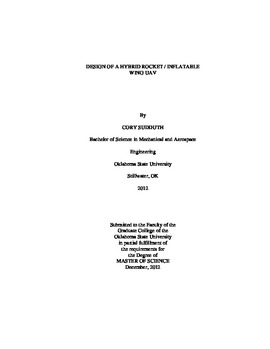| dc.contributor.author | Sudduth, Cory W. | |
| dc.date.accessioned | 2014-04-17T19:54:12Z | |
| dc.date.available | 2014-04-17T19:54:12Z | |
| dc.date.issued | 2012-12-01 | |
| dc.identifier.uri | https://hdl.handle.net/11244/10072 | |
| dc.description.abstract | This paper discusses the design challenges and development of a UAV that transitions from a rocket, which allows the aircraft to reach a target altitude rapidly, and then deploys an inflatable wing from an enclosed shell in midflight to allow for loitering and surveillance. The wing deployment and transition is tested in static and dynamic environments, while the performance and stability of both the aircraft mode and rocket mode are examined analytically. An in-depth discussion of key components, including the design, analysis and testing, is also included. Designing an UAV that transitions from a high velocity rocket, to a slow velocity UAV provides many difficult and unique design challenges. For example, the incorporation of deployable wing technology into a full UAV system results in many design constraints. In this particular design inflatable wings are used to generate lift during aircraft mode, and the stabilizing fins for the main wing also acted as the fins for the vehicle during its rocket phase. This required the balancing of the two different vehicle configurations to ensure that the aircraft would be able to fly stably in both modes, and transition between them without catastrophic failure. Significant research, and testing went into the finding the best method of storing the inflatable wing, as well as finding the required inflation rate to minimize unsteady aerodynamic affects. Design work was also invested in the development of an inflation system, as it had to be highly reliable, and yet very light weight for use in this small UAV. This paper discusses how these design challenges were overcome, the development and testing of individual sub-components and how they are incorporated into the overall vehicle. The analysis that went into this UAV, as well as methods used to optimize the design in order to minimize weight and maximize the aircraft performance and loitering time is also discussed. | |
| dc.format | application/pdf | |
| dc.language | en_US | |
| dc.publisher | Oklahoma State University | |
| dc.rights | Copyright is held by the author who has granted the Oklahoma State University Library the non-exclusive right to share this material in its institutional repository. Contact Digital Library Services at lib-dls@okstate.edu or 405-744-9161 for the permission policy on the use, reproduction or distribution of this material. | |
| dc.title | Design of a Hybrid Rocket / Inflatable Wing Uav | |
| dc.type | text | |
| osu.filename | Sudduth_okstate_0664M_12565.pdf | |
| osu.college | Engineering, Architecture, and Technology | |
| osu.accesstype | Open Access | |
| dc.description.department | Mechanical & Aerospace Engineering | |
| dc.type.genre | Thesis | |
| dc.subject.keywords | deployable | |
| dc.subject.keywords | hybrid | |
| dc.subject.keywords | inflatable wing | |
| dc.subject.keywords | midflight | |
| dc.subject.keywords | rocket | |
| dc.subject.keywords | uav | |
